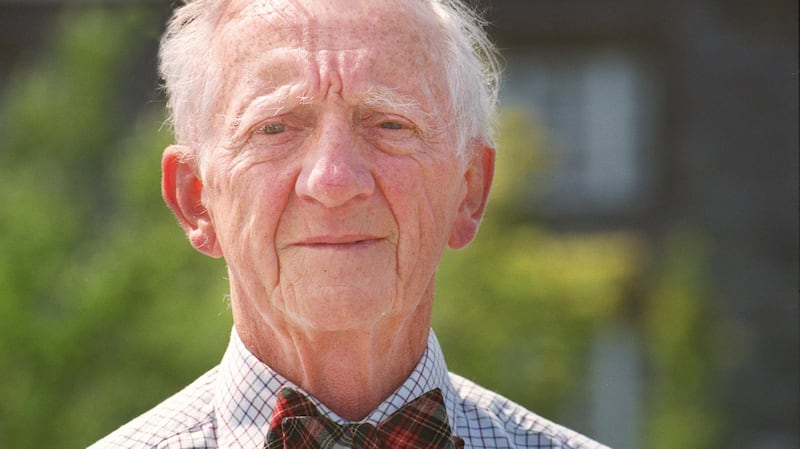Risteárd Mulcahy, who has died in Dublin just before his 94th birthday, was a leading Irish cardiologist and campaigner on heart health. He played a large part in shifting policy towards preventing heart disease, rather than simply treating the symptoms.
His landmark decision in 1970 to ban smoking in cardiac wards in St Vincent’s University Hospital, Dublin, was considered revolutionary by staff and patients alike. He was a founder member of the Irish Heart Foundation in 1966.
To many patients he was “the heart doctor in the dickie bow”. A dapper figure, early in his career he discovered that for a male doctor wearing a bow tie made sense; unlike an ordinary necktie it did not get in the way when examining a patient. He was head of the cardiology department and heart disease research unit at St Vincent’s hospital until his retirement in 1988.

Born in Dublin in 1922, he was one of six children of Richard Mulcahy and his wife Mary Josephine Ryan, known as Min. The couple had connections to both sides in the civil war which scarred the early days of Irish independence.
Mulcahy senior, a rebel turned soldier, was minister for defence in the first Free State government and later leader of Fine Gael.
He was also a polarising figure in the new State, detested by former IRA comrades for the execution of 77 civil war opponents. For protection, the family lived at Lissenhall, a big house adjoining the army barracks at Portobello in the Dublin suburb of Rathmines.
Surgeon
Nonetheless his son travelled across the city daily to school at the Gaelic-speaking Coláiste Mhuire in Parnell Square, and later attended University College Dublin. He qualified as a doctor in 1945, and became resident house surgeon at St Vincent’s, then located on St Stephen’s Green.
In 1946 he moved to London, where he joined the staff at the Hospital of St John and St Elizabeth, St John’s Wood. He trained as a cardiologist at the National Heart Hospital.
In 1950 Mulcahy returned to Dublin and was appointed a junior cardiologist at St Vincent’s. He also set up in private practice in shared rooms in Fitzwilliam Square, and served as medical officer to Our Lady’s Hospice, Harold’s Cross.
In the 1950s he published papers on medical subjects, paying particular attention to the treatment of mitral stenosis. In 1960, he took over all the heart cases at St Vincent’s. He set up the coronary care unit in 1966.
In the early 1970s he became a member of the working groups on epidemiology and prevention, and of the working groups on rehabilitation, of the European Society of Cardiology and the International Society and Federation of Cardiology.
In 2009 he recalled that as recently as the 1980s the prevailing view was that heart disease could be treated, but not prevented. Representatives of the dairy industry, along with many doctors, refused to accept that cholesterol had a role in the development of heart disease, and Mulcahy remembered having to argue his case over a “long and contentious number of years”.
He criticised the overuse of pharmaceuticals in medicine. “They [the medical profession] are not using the drugs properly – they are using too many of them and there is inappropriate drug treatment.”
After he retired he continued to work as a consultant at the Charlemont Clinic, Dublin. He retired completely from medical practice in 2005.
Retirement
Reflecting on
his years at what is now St Vincent’s University Hospital he said: “I had nothing but admiration and respect for the sisters’ [Religious Sisters of Charity, founders and patrons of the hospital] dedication to their calling, for their concern for and care for others, and for their constant good humour, optimism and humanity.”
In retirement he continued to engage in physical pursuits such as cycling and running, and also played golf. A member of the Irish Tree Society, he represented An Taisce on the Irish Tree Council. He also was a member of the Irish Doctors’ Environmental Association.
In addition to books on health matters he also wrote a biography of his father, challenging the way a modest man had been overshadowed by more flamboyant contemporaries, but admitting that his stints as minister for education had not enhanced his reputation.
In a poignant late memoir, Memoirs of a Medical Maverick (2010), Mulcahy wrote of the painful breakdown of his marriage to Aileen (Hanton), with whom he had six children, and who died in 2008. He married a second time, Louise Hederman, a nurse.
In his final years he came to question the benefits of the “incessant search” for prolonging life, pointing to more pressing problems.
Risteárd Mulcahy’s wife Louise and his sons Richard, David and Hugh and daughters Tina, Barbara and Lisa survive him.








